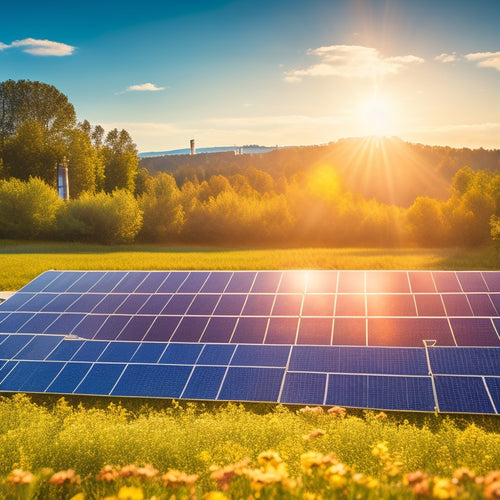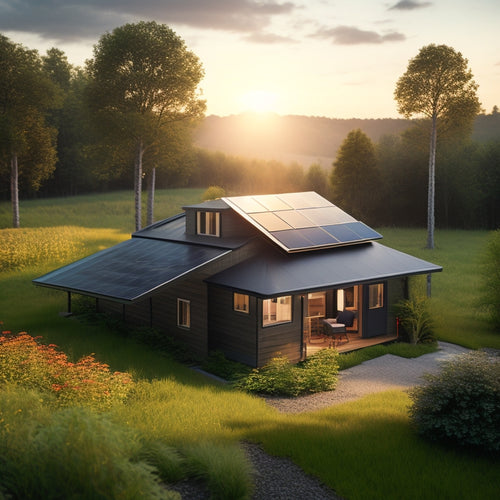
10 Essential Steps to Design Your Energy System
Share
You're about to initiate a thorough expedition to design an energy system that meets your unique needs, and it all starts with a detailed assessment of your energy requirements and available resources. To get started, you'll need to evaluate your energy consumption patterns, assess your roof's solar potential, and choose the right solar panels for your system. Next, select a compatible inverter type, size your battery backup system, and design a safe electrical system. Verify code compliance standards, prepare for installation logistics, and plan for performance monitoring and optimization. As you follow these essential steps, you'll be well on your way to creating a customized energy system that meets your needs now and in the future.
Overview
- Assess energy consumption patterns and calculate total energy needs to determine the required solar panel capacity.
- Evaluate roof size, shape, and material to ensure compatibility with solar panels and optimal energy production.
- Select suitable solar panels, inverters, and energy storage solutions based on efficiency, reliability, and environmental impact.
- Ensure a safe electrical system design that adheres to safety standards, load calculations, and circuit protection measures.
- Plan installation logistics, including site assessments, contingency strategies, and equipment deliveries to ensure a smooth installation process.
Determine Your Energy Needs
How much energy do you really need? To determine your energy needs, you must assess your energy consumption patterns.
Lifestyle factors, such as the number of occupants and appliances, greatly impact your energy usage. Seasonal variations also play a role, as heating and cooling needs change throughout the year.
Conducting a load analysis will help you identify areas for energy efficiency improvements. Consider your future expansion plans, as they may affect your energy requirements.
When evaluating your energy needs, keep in mind the availability of renewable resources and current utility rates.
Calculate your total energy consumption in watt-hours (Wh) per day by reviewing past utility bills for historical energy consumption data energy audit.
Assess Your Roof's Solar Potential
You'll need to evaluate your roof's size and shape to determine the available space for solar panels.
Consider the ideal placement of panels to maximize energy output, taking into consideration factors like roof orientation and tilt.
Additionally, identify any obstacles or shading issues, such as skylights, vents, or nearby trees, that could impact your solar energy system's performance.
It's crucial to guarantee compatibility with your roof material, as certain roof top mounting options require specific integration methods to prevent water damage.
Moreover, consider the structural integrity of your roof to verify it can support the weight of the solar panels.
Roof Size and Shape
Your roof's size and shape play a critical role in determining its solar potential. When evaluating your roof, consider the following factors to guarantee peak energy production.
| Consideration | Impact on Solar Potential |
|---|---|
| Roof Orientation | Ideal orientation is between 15° and 40°, facing south |
| Aesthetic Considerations | Confirm solar panels complement your roof's design |
| Structural Assessment | Verify your roof can support the weight of solar panels |
| Material Compatibility | Ascertain compatibility with roofing materials, such as asphalt shingles or metal |
Solar Panel Placement
After evaluating your roof's size and shape, it's time to assess its solar potential by strategically placing solar panels.
You'll want to take into account solar orientation, installation angles, and shading analysis to maximize panel efficiency and energy generation. Proper placement guarantees ideal energy production, reduces system maintenance, and increases financial incentives.
It's crucial to take into account grid connection and the flexibility of ground-based installations, which offer customized designs based on specific energy needs.
Aesthetic considerations, such as panel color and design, can also impact the overall look of your home.
Additionally, you'll want to factor in the environmental impact of your system and its integration with the grid.
Obstacles and Shading
Get ready to uncover potential roadblocks to ideal solar energy harvesting by identifying obstacles and shading on your roof.
Conduct a shading analysis to pinpoint areas where trees, buildings, or other obstructions cast shadows, reducing solar access. This assessment helps you determine the best solar panel placement and angle for maximum energy efficiency.
Next, develop an obstacle mitigation plan to remove or trim trees, install skylights, or use solar panels with built-in shading mitigation features.
Choose the Right Solar Panels
How much power do you need from your solar panels? This determines the type and number of panels you'll require.
There are three main solar panel types: monocrystalline, polycrystalline, and thin-film. Monocrystalline panels have high efficiency ratings but are expensive. Polycrystalline panels offer a balance between efficiency and cost. Thin-film panels are budget-friendly but less efficient.
Research different brands, comparing their cost, efficiency, and reliability. Consider installation techniques, such as mounting and tracking systems, which affect energy production. Look for warranty options that guarantee performance and durability.
Assess the environmental impact and aesthetic considerations, like panel size and color. By evaluating these factors, you'll choose the right solar panels for your energy system, ensuring maximum power output and freedom from the grid.
Select a Compatible Inverter Type
You'll need to select an inverter that efficiently converts the DC power from your solar panels to AC power for your home.
Look for inverters with high efficiency ratings, as these will minimize energy loss and maximize your system's overall performance.
When choosing an inverter, you'll also need to verify it's compatible with your solar panel array's voltage and current output.
Inverter Efficiency Ratings
Most modern inverters boast high efficiency ratings, typically ranging from 90% to 98%.
When selecting an inverter, you'll want to take into account the type that best suits your energy system. There are string inverters, microinverters, and power optimizers, each with their own advantages and disadvantages.
Look for inverters with high-efficiency ratings, as they'll minimize energy losses and reduce your electricity bills. You should also take into account the inverter's lifespan, maintenance requirements, and features such as monitoring capabilities and warranties offered by manufacturers.
Additionally, inverter technology, upgrades, costs, and placement are vital factors to evaluate.
Inverter Compatibility Checks
When designing your energy system, selecting a compatible inverter type is crucial to guarantee seamless integration with your solar panels and electrical infrastructure.
You'll need to evaluate various inverter types, such as string inverters, microinverters, and power optimizers, and assess their compatibility factors.
Review installation guidelines to verify the inverter you choose can handle your system's voltage, current, and power output.
Efficiency comparisons will help you determine the best inverter for your setup.
Research brand reliability and warranty options to confirm your investment is protected.
Size Your Battery Backup System
Sizing your battery backup system is a critical step in designing an energy system that meets your specific power needs.
You'll need to determine the right battery capacity to provide the necessary backup power during outages or when the grid is unavailable.
Consider your energy usage patterns, including the type and number of appliances you want to power, their wattage, and the duration you need to run them.
You'll also need to factor in the charging cycles, as this affects the overall lifespan of your batteries.
A good rule of thumb is to oversize your battery capacity by 10-20% to account for unexpected energy demands.
Plan Your Energy Storage Needs
By considering your energy usage patterns and battery backup system, you're now ready to investigate the specifics of planning your energy storage needs.
Analyze your energy consumption trends to determine the required storage capacity. This involves identifying peak demand periods, daily energy usage, and the duration of backup power needed.
Recent battery technology advancements have made it possible to store excess energy generated during the day for later use.
Consider the type and number of batteries required, as well as their compatibility with your system. Calculate the total storage capacity needed to guarantee a reliable and efficient energy supply.
Design a Safe Electrical System
With your energy storage needs planned, you can now focus on designing a safe electrical system that integrates seamlessly with your energy generation and storage components.
You must verify your system meets safety standards, starting with proper electrical grounding to prevent shock hazards. Conduct a load calculation to determine the required circuit capacity, and implement circuit protection to prevent overheating and short circuits.
Validate wiring safety by using certified equipment and following recommended wiring practices. Don't forget surge protection to shield your system from power surges and spikes.
Ensure Code Compliance Standards
As you finalize your electrical system design, verifying it meets code compliance standards is essential to avoid potential hazards, fines, and even project delays. You must consider local regulations, safety inspections, and building permits to guarantee a safe and compliant system.
| Code Compliance Aspect | Description |
|---|---|
| Code Updates | Stay informed about changes to local regulations and installation standards |
| Safety Inspections | Schedule regular checks to verify your system meets safety standards |
| Building Permits | Obtain necessary permits before commencing installation |
| Energy Audits | Conduct audits to optimize energy efficiency and reduce waste |
Prepare for Installation Logistics
You'll need to conduct a thorough site assessment to identify potential logistical challenges that could impact your energy system installation.
Ahead, you'll face challenges like maneuvering tight spaces, coordinating with local authorities, and ensuring compliance with regulations.
To avoid delays, plan for deliveries and storage of equipment, and develop a contingency strategy to mitigate any unforeseen issues.
Site Assessment Needed
Conduct a thorough site assessment to identify potential installation obstacles and secure a seamless energy system setup.
You'll need to evaluate your site's orientation, considering how it affects energy production. Environmental factors like shading, wind direction, and weather patterns must also be taken into account.
Research local regulations, financial incentives, and utility partnerships that may impact your system's design.
Consider energy efficiency, maintenance requirements, and community support when selecting your system components.
Stay up-to-date with technology advancements and ascertain system integration with existing infrastructure.
Logistical Challenges Ahead
Beyond the design phase, logistical barriers await, requiring careful planning to secure a smooth installation process.
As you prepare for installation, you'll need to traverse the supply chain to guarantee equipment availability. Regulatory challenges, such as permitting processes and local zoning, can cause delays if not addressed promptly.
You'll need to create realistic installation timelines, considering workforce difficulties and transportation logistics. Failing to plan for these logistical challenges can result in project delays, increased costs, and even project cancellation.
Deliveries and Storage
As the installation timeline takes shape, attention turns to the critical task of preparing for the physical arrival of equipment and materials. You'll need to plan for energy delivery, storage solutions, and logistics to guarantee a smooth installation process.
| Delivery Methods | Storage Solutions |
|---|---|
| Road transportation | Battery banks for energy storage |
| Air transportation | Liquid fuel storage for backup systems |
| Sea transportation | Advanced storage technologies for energy distribution |
You must consider factors like storage capacity, delivery logistics, and backup systems to guarantee your energy system operates efficiently. By planning ahead, you'll avoid delays and guarantee a successful installation.
Monitor and Optimize Performance
Your energy system's performance metrics serve as a roadmap to identify areas for improvement, allowing you to fine-tune its operation and maximize its efficiency.
You'll need monitoring tools to track performance metrics, such as energy analytics and data analysis. This data will help you set efficiency benchmarks and identify opportunities for system upgrades.
Regular performance tracking will enable you to apply optimization techniques, ensuring your system runs smoothly and efficiently. Create maintenance schedules to prevent downtime and troubleshoot issues quickly.
Frequently Asked Questions
Can I Install My Energy System Myself to Save Money?
You're considering DIY installation to save money, but it's essential to weigh the cost-saving benefits against potential risks and challenges; make sure you have the necessary technical knowledge to avoid costly mistakes and safety hazards.
How Long Does It Take to See a Return on Investment?
Fast-forward to financial freedom: you'll find that figuring out the payback period is essential in your investment analysis. Typically, it takes 5-7 years to break even, but this varies depending on your energy usage, system size, and local incentives.
Are Energy Systems Compatible With All Electrical Grids?
You'll find that energy systems can integrate with most electrical grids, but you'll need to address grid integration challenges and guarantee energy storage compatibility to avoid potential disruptions and optimize your system's performance.
Can I Add More Panels or Batteries in the Future?
You can easily scale up your energy system in the future by adding more panels or batteries, as long as you guarantee panel compatibility and plan for future expansion, giving you the freedom to adapt to your changing energy needs.
Will My Energy System Still Work During a Power Outage?
It's a lucky coincidence you're thinking ahead! During a power outage, you'll be grateful for backup solutions like battery banks and inverters, ensuring your energy system still works, providing power reliability when you need it most.
Ready to Buy
Now that you've maneuvered the 10 essential steps, your energy system is like a finely-tuned orchestra, with each component working in harmony to generate, store, and distribute power. The solar panels are the skilled musicians, the inverter is the conductor, and the battery backup system is the rhythm section. With a safe and compliant design, your system is ready to perform in perfect sync, providing a performance of clean energy for years to come.
Related Posts
-

Advantages of Solar Generating Systems Over Traditional Energy
Solar generating systems provide several key advantages over traditional energy sources. You'll experience lower long...
-

Diy Off Grid Solar
By embracing DIY off-grid solar, you can break free from grid dependence, slashing your energy bills by up to 90% and...
-

Top Solar Powered Camping Fans for Camping Enthusiasts
If you're a camping enthusiast, a solar-powered fan can be a transformative element for your outdoor experience. Thes...


